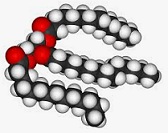The term lipid , which comes from the French word lipide . This is a French word that has a very unique etymological origin. And it is the result of the sum of two clearly delimited lexical components:
-The Greek term “litos”, which can be translated as “fat”.
-The Latin suffix “-ido”, which is used to indicate “appearance of”.
It is used to refer to the organic compound that is formed from the esterification of alcohols with fatty acids .
 Let us remember that an alcohol is a compound that has the hydroxyl group linked to an aliphatic radical or a derivative. A fatty acid , meanwhile, is an organic acid combined with glycerin for the development of fats. The idea of esterification , finally, is linked to the creation of an ester through the union of an alcohol and an acid .
Let us remember that an alcohol is a compound that has the hydroxyl group linked to an aliphatic radical or a derivative. A fatty acid , meanwhile, is an organic acid combined with glycerin for the development of fats. The idea of esterification , finally, is linked to the creation of an ester through the union of an alcohol and an acid .
Specifically returning to the idea of lipid , it is an organic molecule composed mainly of carbon and hydrogen . In a lower amount it contains oxygen and may also contain nitrogen , sulfur or phosphorus .
Lipids, which cannot dissolve in water (they are hydrophobic ), perform important functions in living beings. They serve, for example, as an energy reserve since, through a metabolic oxidation reaction, they produce calories.
In addition to everything indicated, we cannot ignore the existence of two clearly defined types of lipids:
-Unsaponifiable lipids, which have the particularity that they cannot be hydrolyzed and do not have the so-called ester bonds. Among the most significant of this type are steroids, terpenoids and prostaglandins.
-Saponifiable lipids, which can be hydrolyzed and do have ester bonds. Within this group we have to establish the existence of two differentiated types: simple and complex. The simple ones are those that have hydrogen, carbon and oxygen. Complexes, for their part, are those that, in addition to hydrogen and carbon as well as oxygen, have nitrogen, sulfur or phosphorus, for example.
On the other hand, lipids contribute to the body's thermal regulation , promote the development of various chemical reactions and even collaborate with the protection and formation of organs.
In addition to the two functions mentioned, lipids carry out some more. Thus, for example, they perform a structural function, with which they not only protect the body's structures but also provide consistency to the organs.
In the same way, they are responsible for undertaking another transport task and also another function of regulation or cellular communication. The latter responds to the name of biological function and consists of both regulating metabolism and reproduction.
When grouped together, the cells that are responsible for the accumulation of lipids (called adipocytes ) form adipose tissue . This tissue helps keep internal organs and other structures in place and also protects them. It also constitutes a lipid reserve.
It is important to note that fats are a specific class of lipids. That is why using both concepts as synonyms is not correct, since there are lipids that are not fats.
